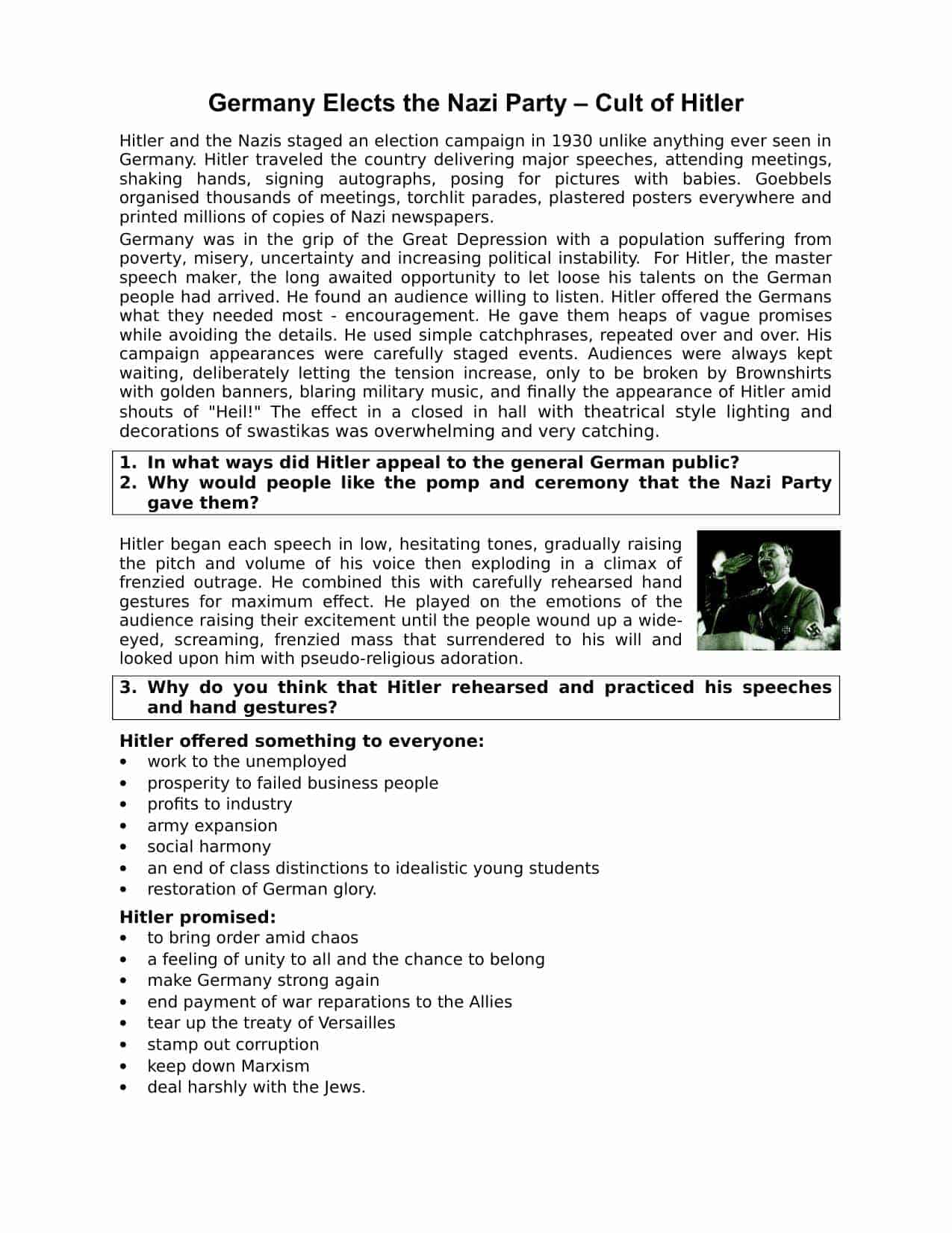Download Hitler gets into Power Lesson Worksheet
Click the button below to download this worksheet for use in the classroom or at home.
Download →
Hitler and the Nazis staged an election campaign in 1930 unlike anything ever seen in Germany. Hitler traveled the country delivering major speeches, attending meetings, shaking hands, signing autographs, posing for pictures with babies. Goebbels organised thousands of meetings, torchlit parades, plastered posters everywhere and printed millions of copies of Nazi newspapers.
Germany was in the grip of the Great Depression with a population suffering from poverty, misery, uncertainty and increasing political instability. For Hitler, the master speech maker, the long awaited opportunity to let loose his talents on the German people had arrived. He found an audience willing to listen. Hitler offered the Germans what they needed most – encouragement. He gave them heaps of vague promises while avoiding the details. He used simple catchphrases, repeated over and over. His campaign appearances were carefully staged events. Audiences were always kept waiting, deliberately letting the tension increase, only to be broken by Brownshirts with golden banners, blaring military music, and finally the appearance of Hitler amid shouts of “Heil!” The effect in a closed in hall with theatrical style lighting and decorations of swastikas was overwhelming and very catching.
Hitler began each speech in low, hesitating tones, gradually raising the pitch and volume of his voice then exploding in a climax of frenzied outrage. He combined this with carefully rehearsed hand gestures for maximum effect. He played on the emotions of the audience raising their excitement until the people wound up a wide-eyed, screaming, frenzied mass that surrendered to his will and looked upon him with pseudo-religious adoration.
Hitler offered something to everyone:
• work to the unemployed
• prosperity to failed business people
• profits to industry
• army expansion
• social harmony
• an end of class distinctions to idealistic young students
• restoration of German glory.
Hitler promised:
• to bring order amid chaos
• a feeling of unity to all and the chance to belong
• make Germany strong again
• end payment of war reparations to the Allies
• tear up the treaty of Versailles
• stamp out corruption
• keep down Marxism
• deal harshly with the Jews.
The name of the Nazi party itself was all inclusive – the National Socialist German Workers’ Party. All of the Nazis, from Hitler, down to the leader of the smallest city block, worked tirelessly, relentlessly, to pound their message into the minds of the Germans.
On September 14, 1930, the Nazis received 6,371,000 votes in a national election and were thus entitled to 107 seats in the German Reichstag. It was a stunning victory for Hitler. Overnight, the Nazi party went from smallest to second largest in Germany. It propelled Hitler to solid national and international prestige and aroused the curiosity of the world press. He was besieged with interview requests. Foreign journalists wanted to know:
• What did he mean by tear up the Treaty of Versailles and end war reparations?
• Why did he think that Germany wasn’t responsible for the first World War?
Gone was the Charlie Chaplin image of Hitler as the laughable fanatic behind the Munich Putsch. The revolutionary had been replaced by a skilled manipulator of the masses. On October 13 1930, dressed in brown shirts, the elected Nazis marched in unison into the Reichstag and took their seats. When the roll call was taken, each one shouted, “Present! Heil Hitler!” They had no intention of cooperating with the government, knowing it was to their advantage to let things get worse in Germany, thus increasing the appeal of Hitler to an ever more miserable people.
The years 1930 and 1931 were politically good for Hitler. The Nazis were the second largest party in Germany. Hitler had become a best-selling author, Mein Kampf sold over 50,000 copies, bringing him a nice income. The Nazi party had fancy new headquarters in Munich, the Brown House. Money was flowing in from German industrialists who saw the Nazis as the wave of the future. They invested in Hitler in the hope of getting favors when he came to power. Their money was used to fuel Goebbel’s propaganda machine.
The German Army was also investing support in Hitler, hoping he meant what he said about tearing up the Treaty of Versailles which limited the Army to 100,000 men and prevented modernisation. Hitler sent a message to the Army that there would be no attempt to replace the regular Army with an army of SA storm troopers and that once in power, the Nazis would raise the German Army to new heights of greatness. This was exactly what the generals wanted to hear.
It was the SA who gave Hitler problems. Many of the violent SA wanted to become a new German revolutionary army. They embarrassed Hitler by wreaking havoc in the streets despite his order to lay low. Hitler used the SS to put down a small SA revolt in Berlin led by Captain Walter Stennes. Hitler installed former SA leader, Ernst Röhm, as the new leader to reorganize and settle down the SA, now numbering over 60,000 members. The SA, however, and its leadership would remain a problem for years for Hitler, culminating in a major crisis a few years down the road.
Worksheet Lesson Plan:
- Aimed at Students studying across UK Year 7,8 & 9 or equivalent
- Premium resource
- Use as you wish in the classroom or home environment
- Structured information sheet on Hitler getting into power in Germany.
- 13 challenging questions throughout the lesson worksheet.
